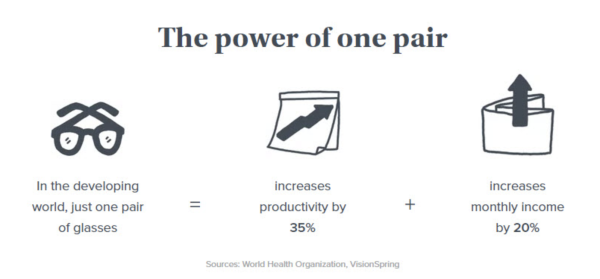For the last several years, not a month has gone by without at least one well-meaning, concerned employee pulling Keap CEO Clate Mask aside and asking him something like, "Clate, how are we going to preserve our amazing culture as we continue to grow at such a fast pace?"
He always tells them that the company will be true to their Core Philosophy and they'll be just fine. But the truth is, a few years ago, Keap had just raised venture capital, we were about to begin hiring at a very brisk pace, and even Clate wondered how he would preserve the company culture.
The company culture has not only survived but thrived because it is centered on a clear vision, with a set company purpose, mission and values so everyone pulled together toward the same goals.
This is why workplace culture is key to business success.
Read on to find out how you can replicate this success in your own business.
A strong company culture starts with a clear vision
When your company's vision is crystal clear, your entire organization gains clarity. You have alignment and harmony with employees and with the work. You attract amazing talent to the vision. Your vision can inspire and motivate.
When the vision is clear, it is easier to make decisions within the company. Filtering what you do as a business and what you commit to each and every day becomes easier as you consider your vision in the decision process. If the decision aligns with the company purpose, the business values, and the mission, then you can invest time, resources, management attention to it; if not, then you don't waste time working on whatever you were considering.
When the vision isn't clearly defined, resources within the company are scattered with hardly any alignment. Employees aren't working in the same direction; having a vision unifies the work.
The foundational work of creating a vision is found in the elements of purpose, mission and values. Your company purpose is your "Why", your mission is your "What," and your business values are your "How."
What's your purpose?
First, you must set your business purpose statement -- why the business exists, articulated in just a few words.
Keap's purpose is "We Help Small Businesses Succeed." It's clear, short (easy to remember), and impactful. It's a cause people get behind.
Here are a couple more business purpose statements from our Elite Forum Attendees:
DC Mosquito Squad: "Connecting people in their outdoor spaces."
Caboodle: "To empower people to anticipate and manage their money matters."
Your purpose is something that should stand the test of time. It will never change. It could last 100 years or more. And yes, it could be the same as someone else's business. This is not marketing for your company, it is the why of what you get excited about. It drives everything you do in your company.
If Keap's purpose was to "sell software" we wouldn't be a 600-plus employee company and have had the significant growth we've had. "Selling software" isn't worth devoting your life to. Helping small businesses succeed is.
If you haven't read Jim Collins' book Built To Last, you should check it out before sitting down to write your business purpose statement. It's a great primer on setting the foundation of a great, lasting company by first establishing what the company stands for.
Set your mission

Once your business purpose statement is written, it's time to establish your mission. This establishes what, exactly, you will accomplish in the next three to five years, and it aligns and supports your purpose.
Your mission should be both achievable and aspirational. It states what you are going to do and by when. It is best to focus on the next three to five years as you aim to accomplish your "what."
For example, at Keap, our mission is to simplify growth for millions of small businesses worldwide.
Patagonia's mission is: "Build the best product, cause no unnecessary harm, use business to inspire and implement solutions to the environmental crisis."
And Warby Parker's mission is: "To offer designer eyewear at a revolutionary price, while leading the way for socially-conscious businesses."

Articulate your business values
The final step in creating your company vision is articulating your values. Your values are the "how"how you accomplish your purpose and how you manage your mission.
These values should describe what is, not what could be. They represent your core beliefs. You and your team are already manifesting these daily in the company walk and talk. If your employees don't believe in the values you create, then the job won't jive and won't fit well for them. It will become clear that they don't fit in your vision.
There are nine core values at Keap, all of which govern the way our company does business and supports our purpose of helping small businesses succeed.
For instance, in order to help small businesses succeed, the value, "We genuinely care," needs to be ingrained in each employee that works at Keap. And it isn't always easy being a part of a company that grows quickly, so the value, "We Learn Always," is really important for all employees to embrace.
Adobe's core values are "genuine, exceptional, innovative and involved."
And Build-A-Bear's values are un-bear-ably sweet: "Reach, learn, di-bear-sity, colla-bear-ate, give and cele-bear-ate."
Now that you've created your company vision, your work creating a strong culture isn't done yet. The vision creates fertile ground for workplace culture to take root and grow but you must take steps to tend that culture as your company grows.
How to maintain culture in a growing company
We've seen it again and again while working with businesses at $1 million in revenue plus: As they put together a clear vision and ultimately hire, train, and fire employees to their vision, they begin to really scale up.
Once you make your purpose, mission and values a part of your every day, you quickly grow in the right direction with the right people on your team.
There are four things you must do, however, to maintain culture in a growing company:
1. Hire and fire to your core philosophy
Don't hire the best or smartest people.
Yes, you read that right.
Don't hire the best or smartest people. Instead, hire the best or smartest people who **** fit **** your core philosophy.
Bill Gates is brilliant. But Apple should never hire him. Hire for fit. And fire people as soon as you realize they're not good fits for your organization.

We have an unusual and unusually effective practice for weeding out bad fits misfits quickly here at Keap. After new hires complete their initial two weeks of orientation, they are offered $5,000 to quit. It gets rid of the misfits and it increases the commitment level of new hires who are a fit.
2. Constantly teach your people, especially the leaders, your core philosophy
Every employee must understand the values and purpose of the company. If the leaders don't firmly buy into the core philosophy, the people will never buy in.
Ultimately, it's the CEO's responsibility to entrench the core philosophy. When Keap was first establishing its core philosophy, CEO Clate Mask took a note from Verne Harnish's book Mastering the Rockefeller Habits. In it, Harnish stated that if a leader's people weren't mocking him about the core philosophy, he wasn't pushing hard enough. And if they were mocking him, he was on the right track.
Right before Clate was about to give up on hounding his employees about the core philosophy, he decided instead to push a little harder and within a few weeks, the tide turned. He got full buy-in, and the Keap culture has been rockin' ever since.
3. Hire a senior leader to oversee the culture
There are so many little details to developing a successful culture that the CEO or executive management can't effectively manage them all on their own.
This leader's over-arching objective is to ensure the organization is preserving the core values while stimulating progress, keeping the leaders and employees constantly focused on the core philosophy.
4. Dedicate time each month to evaluate the culture
Once you've set your vision, you've got the mechanisms in place for hiring and firing the right people, and the leadership in place to ensure a strong culture, the last piece is to consistently allocate time to review the state of the culture. By maintaining a close connection to the staff and leadership, and dedicating time to address issues that will inevitably come up, you'll find that the values actually help keep your company on course to accomplish its mission.
A great culture doesn't have to die as a company grows. In fact, a great culture should thrive with growth. We have studied Disney, Netflix, and Zappos as examples of companies that have grown and maintained a great culture, and we are determined to do the same at Keap.
Get clear on your vision and a strong culture will take root
As you get clear on your vision no matter what stage your business is in you will begin to hire the right people for the job, and your team will become aligned to your vision as the creator and founder of your company. And as your company grows, be sure to keep that vision and culture at the forefront to weather any change together.


